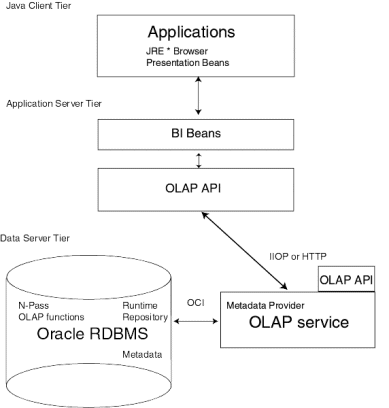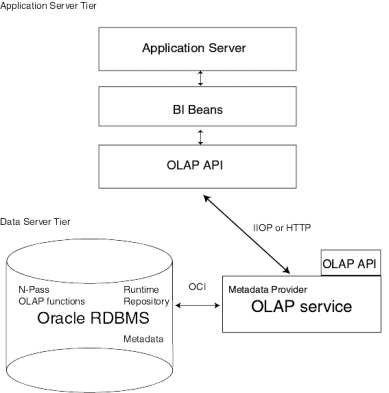Release 1 (9.0.1)
Part Number A88755-01
Home |
Book List |
Contents |
Index | Master Index | Feedback |
| Oracle9i OLAP Services Concepts and Administration Guide Release 1 (9.0.1) Part Number A88755-01 |
|
Developing OLAP Applications, 2 of 5
To develop an OLAP application, you use the Java programming language. Java enables you to write applications that are platform-independent and easily deployed over the Internet.
Java is the preferred programming language for an ever-increasing number of professional software developers. For those who have been programming in C or C++, the move to Java is easy because it provides a familiar environment while avoiding many of the shortcomings of the C language. Developed by Sun Microsystems, Java is a secure, object-oriented, portable, and multithreaded language.
The OLAP API is a Java-based application programming interface that provides access to multidimensional data for analytical business applications. The OLAP API fetches data stored in a data warehouse into the OLAP multidimensional data cache for manipulation by its analytical engine. Java classes in the OLAP API provide all of the functions required of an OLAP application: Connection to an OLAP instance; authentication of user credentials; access to data in the RDBMS controlled by the permissions granted to those credentials; and selection and manipulation of that data for business analysis.
The BI Beans simplify application development by providing these functions as JavaBeans. Moreover, the BI Beans include JavaBeans for presenting the data in graphs, crosstabs, and tables.
With the rise in Internet technology, more and more businesses are recognizing the savings they can accrue just by changing the way they deploy their applications.
Traditional thick client applications implement many of their functions on the user's computer, thus requiring a large proportion of installed code. However, the days are gone when a team of technicians are required to install and maintain applications software on hundreds or thousands of individual desktop computers for a large user base. Instead, Java thick-client applications download the needed software to client computers automatically at run-time.
Alternatively, system administrators can deploy thin client applications that do not download any Java to client computers. These applications run on servers that users world wide can access using Java clients such as their Web browsers.
Regardless of whether you choose a thick-client or a thin-client configuration, Java applications provide an immediate solution to the problems inherent in supporting large user communities, which typically are equipped with a variety of incompatible hardware and software platforms.
Oracle JDeveloper provides an integrated development environment (IDE) for developing Java applications. Although third-party Java IDEs can also be used effectively, only JDeveloper achieves full integration with the Oracle database and BI Beans wizards. The following are a few JDeveloper features:
For more information about the Java programming language, browse the Sun Microsystems Java Web site at java.sun.com. For information about JDeveloper, search the Oracle Web site at www.oracle.com.
The OLAP API and the BI Beans use metadata to provide the information they need about multidimensional objects defined in an Oracle data warehouse, such as measures and dimensions. For information about metadata and other requirements, refer to Chapter 4.
A runtime repository in the Oracle database allows users to save their personal analyses and to share their discoveries with other users.
The components of an OLAP thick-client application are grouped into three tiers, which can be on separate platforms or the same platform:
The following diagram shows these relationships in a thick-client configuration.

The components of an OLAP thin-client application are grouped into two tiers, which can be on separate platforms or the same platform:
The following diagram shows these relationships in a thin-client configuration.

|
|
 Copyright © 1996-2001, Oracle Corporation. All Rights Reserved. |
|